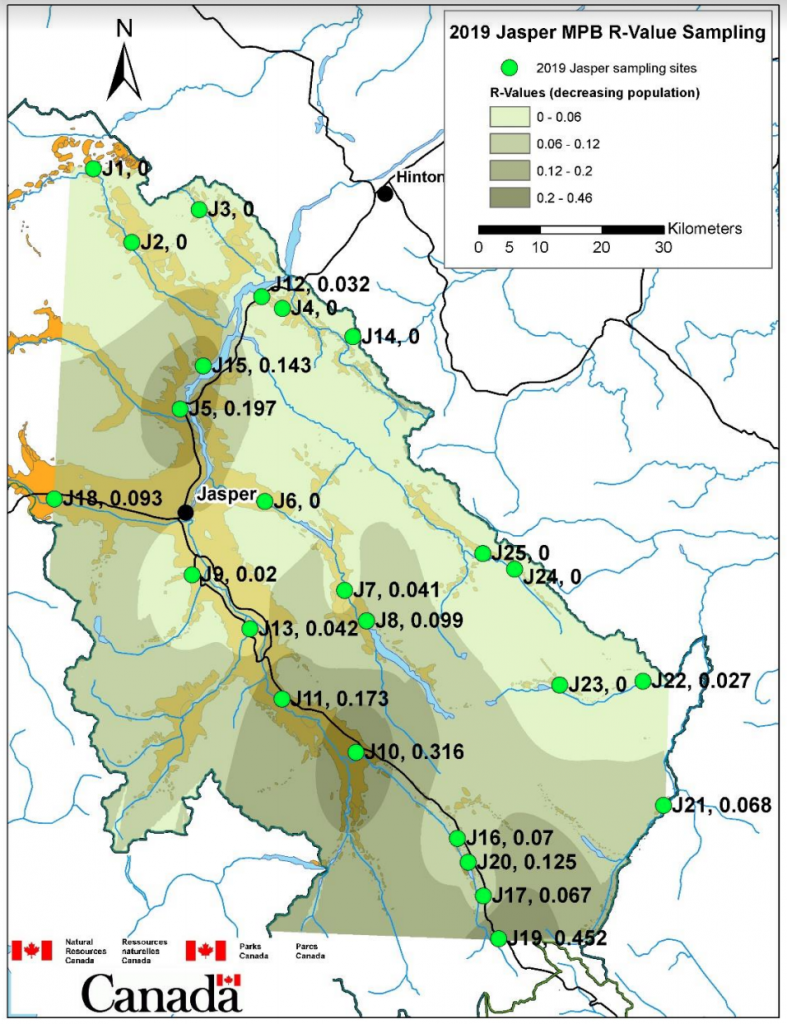
Fuchsia Dragon | [email protected]
To the disbelief of many, Jasper’s pine beetle population was mostly wiped out this winter.
Last week, Parks Canada told the Fitzhugh a recent survey showed a 98 per cent mortality rate in pine beetles in Jasper National Park.
And exactly how they got that number and why this happened has been revealed in the survey’s official report.
Natural Resources Canada and the Canadian Forest Service conducted the mountain pine beetle population assessment in Jasper from April 29 to May 6 this year.
In total, 25 plots were sampled across Jasper’s pine beetle outbreak.
Currently attacked trees were sampled at least 50 metres from the forest’s edge and public areas were avoided.
Sample trees were selected at random and were sampled on the north and south sides of the tree.
The trees were sampled by exposing a six-inch square patch of bark using a chisel and mallet, using a “tree apron” to catch any falling larvae.
Experts counted the number of live beetles at all life stages, the number dead, maternal galleries, entry holes showing attack starts, and predator/parasite information.
The data was then entered in a spreadsheet and summarized.
The Canadian Forest Service then calculated an “R-value” for each site by taking the number of live beetles for the entire site and dividing that number by the total of attack starts for the site.
“All sites surveyed are classed well under the limit depicting a decreasing population,” said the report, prepared by Roger Brett, a forest health supervising technician.
The site where the most live larvae were found (only totaling 28) was J19, the southernmostsite along Highway 93 near the Stutfield Creek area.
The next highest count was from J10 at Sunwapta Falls, where only 12 live pine beetles were found.
“Although these numbers are very small, barring predation, they will mature, emerge, attack anew and mate,” the report said.
“Sampling is also very limited relative to the size of the outbreak, so it’s very possible areas of survival exist but went unsampled.
“That’s said, sample distribution was very good so confidence on outbreak status is high.”
According to the report, on top of this February’s cold snap that brought close to -40°C temperatures, the beetles reproduction and development was very delayed.
Evidence suggests that 2018 beetle flights were spread out between July and September, resulting in failed mating and eggs not being laid.
Eggs and immature larvae overwintered, increasing their susceptibility to mortality due to cold temperature.
“This poor reproduction played a big role in the decline,” the report said.
And the polar vortex this winter brought cold temperatures not seen for many years.
Anything colder than -37 degrees is known to cause serious mortality in pine beetles and there were two days in February and one in early March where close to -40 degrees was reached.
“In addition, it is possible the rate of the drop to reach those killing temperatures may have played a role,” the report said.
The February drop in temperature came fast, increasing the detrimental effect on larvae, especially to eggs and immature larvae, which are already more susceptible to cold.
Despite Jasper pine beetle populations having all but “collapsed”, the area of red trees will still grow this year as last year’s attacks take hold.
It takes about a year for needles to turn yellow, orange and red after pine beetles have attacked a tree.
According to the report, the south will be where most of the new mortality is recorded and will be where any new attacks happen in 2019.
“The true success of 2018/19 overwintering mortality will not be known until the 2020 spring faders start to show.”



